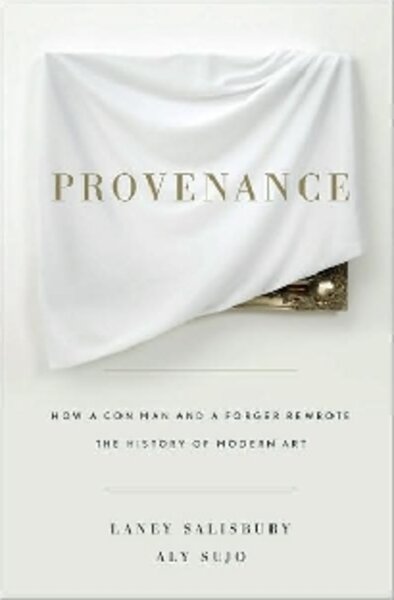Provenance
Loading...
What is provenance? Good guess! But no, it’s not the capital of Rhode Island. Provenance means “origin,” as in, “What is the provenance of that famous work of art?” It is the paper trail of receipts, auction listings, exhibition catalogues, and letters of authenticity that accompany a piece of art through time.
Provenance serves as an artwork’s passport, its certification – a mandatory starting-point for any transaction or public exhibition of note. How would dozens of forged “modern masterpieces” be able to pass through the highest levels of expert scrutiny without provenance? They wouldn’t. And that’s what makes Provenance: How a Con Man and a Forger Rewrote the History of Modern Art such a fascinating tale.
Husband-and-wife authors Laney Salisbury and Aly Sujo spin the preposterous but true story of an unlikely pair: a dapper and charming London con man, John Drewe, and his malleable forger, John Myatt, a penniless part-time art instructor and single father of two. Together they perpetrated perhaps the greatest art fraud of the 20th century.
Myatt had a talent for mimicking any art style, so, badly strapped for cash, he placed an ad in London’s satirical magazine Private Eye, which had the kind of well-heeled and hip readership that might respond to his offer of “genuine fakes – facsimiles of 19th- and 20th-century paintings.” The ad worked, bringing the impoverished painter several much-needed commissions.
“His clients for the most part were cultural tourists, mall safarians who weren’t ashamed to buy a painting that would go nicely with the curtains,” write Salisbury and Sujo. What Myatt was doing was completely legal. Such copies can be found in hotel rooms and McMansions the world over.
Shortly after posting the ad, Myatt received a call. A caller with a polished and distinctly upper-class English voice introduced himself as “Dr.” John Drewe and asked Myatt to paint “a nice Matisse, something colorful, memorable, not too large.”
Pleased with the results of his first commission, Drewe ordered several more from Myatt. Although claiming that the fakes were gifts for his wife and friends, Drewe was already reselling them as genuine. If Myatt suspected his deep-pocketed client was up to something, it didn’t stop him from grabbing a paintbrush each time Drewe called in another order.
In the early stages of the deception, a few buyers of the forgeries became suspicious and asked for proof of the paintings’ lineage. Drewe, who never finished high school, began masquerading as a wealthy physicist with a PhD, consultant to the British Atomic Energy Authority, and university professor with a large collection of modern art.
He sought out well-known patrons of the arts, wining, dining, and regaling them with fascinating – and completely fabricated – stories of his life. Each conquest became an unwitting part of his scheme. Some served to deflect suspicion while others helped Drewe to gain entree to the upper echelons (and, more important, the basement archives) of the London art scene, including the Tate Gallery. (Drewe’s “generous donation” of a Giacometti and a Le Corbusier to the Tate certainly didn’t hurt – especially since he’d only paid £150 apiece for Myatt to paint them a few weeks earlier.)
Soon Drewe was a welcome visitor to the Tate’s tightly guarded archive vaults and came and went with regularity – removing genuine documents and planting his own cobbled-together fakes as he went.
Salisbury and Sujo recreate the moment Myatt suddenly realized what he’d gotten himself into: “The professor was standing at this dining room table, which was covered with piles of documents. Drewe seemed as gleeful as if he’d just won the lottery. ‘Take a good look,’ he said.” Myatt was stunned at the audacious haul. “How did someone walk out of a major British institution ... with its entire history in hand?
Drewe was a quick study, becoming such an expert in fine-art provenance that much of the forged, copied, pasted, retouched, and manipulated ephemera he insinuated into the precious archives of art history is still there, hiding in plain sight. He purloined and recreated exhibit catalogue pages, adding photos of Myatt’s creations right alongside genuine ones of works by Giacometti, Braque, and Dubuffet, complete with serial numbers, auction histories, and letters of authenticity from elite experts and collectors.
Between 1986 and 1995, Drewe and Myatt passed an estimated 200 forged paintings, with convincing provenances, into the art world. To date, only 73 have been unmasked.
Most scams, even magic-tinged ones like the Drewe/Myatt affair, eventually crash and burn. I won’t spoil the ending of this intoxicating page-turner for you, except to say that it had everything to do with two women. The first was the keeper of the Giacometti estate, an acutely skeptical Frenchwoman who simply would not take “yes” for an answer, especially when her intuition told her otherwise. The other was Drewe’s common-law wife and ex-Israeli soldier, Batsheva – a woman scorned (and not one to fade quietly into the night). Perhaps if Drewe had been as resourceful and meticulous a husband as he was as a forger...
This irresistible book recounts its preposterous yet authentic tale with meticulous detail and bemused detachment. Warning: Don’t read too close to bedtime. “Provenance” is impossible to put down, as my repeated yawns as I write this attest.
John Kehe is the Monitor’s design director.






